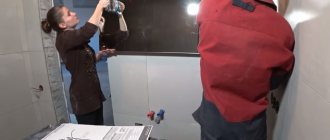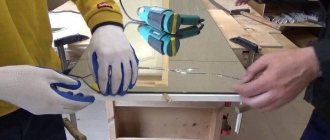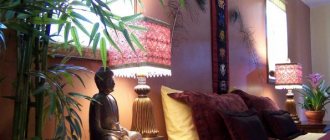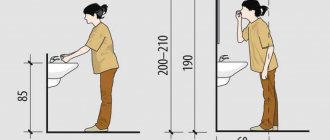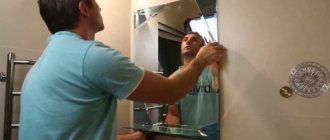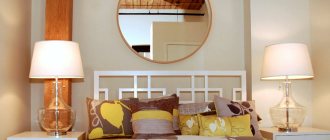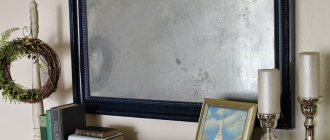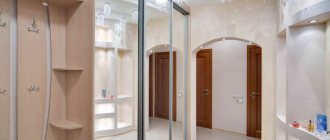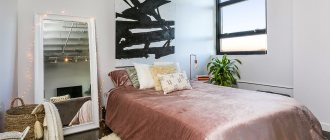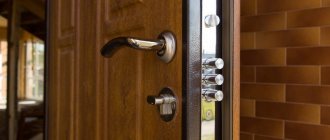Mounting a mirror on the wall is an element that is not always needed, since you can fix a mirror with your own hands using several methods; here you need to take into account the characteristics of the wall material and the parameters of the mirror itself. Even a beginner without any experience can handle the process of installing a small mirror; in other cases, you will need to study detailed instructions. Today we will look at the basic methods of installing mirror structures.
Wall mirror mount
Basic methods for mounting mirrors to the wall
When arranging your home, sometimes it becomes necessary to hang a mirror on a wall or cabinet. You can do this in the following ways:
- using special glue or sealant;
- install structure holders;
- make holes and secure it to the wall or to the door with screws or self-tapping screws;
- attach using adhesive mounting tape.
Using these methods, you can install this accessory in a room for any purpose without using the services of a specialist. Let's look at the installation options in more detail.
We fix the canvas to the wall
Nuances of work taking into account the type of surface
There are several types of wall surfaces on which mirrors can be attached:
- concrete;
- drywall;
- brickwork;
- PVC panels;
- tile.
Functionality of a mirror with lighting for makeup, types of products
When installing a mirror on a wall, preliminary preparation is required. The choice of fixation method depends on the type of surface on which the canvas needs to be fixed.
| Surface type | Method of preparation | Mounting type | Tools, materials | Surface strength, mirror weight |
| Concrete | Coat with primer | Glue, sealant | Hammer, primer, glue, sealant, construction gun | Lasting, weight - 8–10 kg |
| Drywall | Clean from dirt and dust | Anchor bolts, butterfly dowels | Drill, screwdriver | Fragile, maximum weight - 20 kg |
| Brick | Coat with primer | Glue, sealant | Hammer, primer, glue, sealant, construction gun | Durable, medium weight |
| PVC panels | Installation of sheathing | Glue, tape | Glue, sealant, construction gun | Lightweight models, as the surface is fragile |
| Tile | Clean from dirt and dust | Dowel screw, glue, sealant | Concrete drills, electric drill | Not very heavy, medium surface strength |
The mounting method is selected based on the design, weight of the product, as well as the type of wall
A light mirror can be glued to a flat wall with liquid nails
You can hang a mirror on a plasterboard wall using a butterfly dowel
Rules for determining mirror installation height
Using sealant and glue
Products weighing about 8-10 kilograms can be safely fixed to the wall using glue or sealant. This way you can quickly hang the product without damaging the wall surface.
During the installation process, a special glue is used; it differs from standard types in that it does not damage the coating. At the same time, it must have good adhesive properties, otherwise the product may collapse at any moment.
Table No. 1. Popular types of glue.
| View, illustration | Description |
| Mounting adhesive “Moment” | This glue is made from synthetic rubber. Thanks to this feature, it does not become hard after drying, but remains flexible, like silicone. It is best suited for application to plaster, natural wood and other surfaces. |
| SOUDAL 47A | This glue, like the previous version, is made on the basis of rubber. It is suitable for tiles, concrete surfaces, various plasters. Its main advantage is that it quickly sets and securely fixes the canvas to the wall. At the same time, it contains a minimum content of acetone (a large amount of it leads to damage to the low-quality mirror coating). However, if the mirror is thin, it is better to test on an inconspicuous place or similar unnecessary piece before using such glue. |
| Tytan | Glue is made based on resin and rubber of synthetic origin. It is best suited for attaching products to porous walls (decorative plaster). It hardens in about 15 minutes, so after attaching the mirror you need to support it with something or just hold it. |
| Penosil | A durable adhesive that can be used on both stone and wood surfaces. It is most often used for products coated with epoxy. It is distinguished by its fast setting - it hardens in about 10 minutes. |
Quite often, for gluing mirrors, silicone sealant is used, which has almost the same properties as specialized adhesives. Before purchasing, it is important to carefully study the composition of the sealant - it should not contain acids. Any acid instantly or over time eats through and damages the mirror coating.
Silicone sealant
Accordingly, a sealant containing any components (except acids) is suitable for installing mirrors, but when installing a mirror in a bathroom, it is better to choose options with antifungal additives. This sealant is often used in rooms with a swimming pool, in saunas and baths. The only difference between waterproof sealant is its higher cost.
The main advantages of the sealant include the following:
- installation will take no more than 60 minutes;
- the product will last on the wall for about 12 years;
- no need to purchase additional fasteners;
- if glue accidentally gets on the front side of the mirror, it can be quickly removed;
- the mirror will fit securely to the wall;
- you will not need to use any additional tools or accessories.
You can “plant” a mirror using either special glue or sealant.
There are also some disadvantages of sealant:
- this method of gluing the product is only suitable for a flat surface;
- it is often impossible to remove the mirror without damaging it;
- in the presence of frequent temperature changes, the strength of the sealant is compromised.
Prices for silicone sealant for wood
Silicone sealant
Mirror gluing technology: step-by-step instructions
Fixing a mirror on the wall with glue is not difficult; you just need to know some nuances.
Step 1. First, the surface on which you plan to attach the mirror must be cleaned of all kinds of dirt and dust. Then you need to wait some time until the wall dries.
Removing dirt from the wall
Step 2. Now you should put markings on the wall that will make it easy to align the mirror.
Apply level markings
Step 3. Next, you need to apply glue or sealant to the back side of the mirror sheet. You can distribute it in a zigzag or in small dots.
Apply glue to the canvas and then fix it on the wall
If we are talking about gluing a mirror that is too voluminous, then the installation method will change slightly. In this case, the glue is applied directly to the surface itself and then spread using a special spatula. Only then is a mirror attached to the wall. You can move it using suction cups.
Apply glue to the wall using a spatula
Installing a mirror using glue can be considered reliable. In this way, they even glue products to the bathroom, where the tiles and the canvas should be located in the same plane. When renovating, it is better to leave room for the mirror so that it can be mounted flush.
You will need to leave some free space where the canvas will be fixed.
Another feature is that not all types of glue set immediately, as a result of which the mirror will slide down. Therefore, several pieces of double-sided tape are first attached to the back side of the canvas, or mechanical fixation of the canvas is provided while the glue dries.
Prices for construction glue Moment
Construction adhesive Moment
Video - Gluing the mirror with sealant: rules
Methods for attaching a mirror to the wall
Large frames for this item are becoming irrelevant, and more and more often you can find the product “floating” in the air, which gives a feeling of lightness to the interior.
There are several options for hanging a mirror on the wall without mounting and invisible fittings, which will ensure safe operation and a beautiful design without a frame.
They contribute to the visual expansion of space and help to install special “diffused” light in the rooms.
Manufacturers offer special compounds that provide good adhesion to the surface, without drilling holes and fasteners.
It is very important to know how to correctly place a mirror on the surface chosen for this.
Sealant and glue
This is the simplest and safest method of fastening, but during installation you need to ensure a perfectly flat surface. A special adhesive-sealant will reliably glue a product of any thickness and size to the base.
The easiest way to install a mirror without a frame is to glue it to the surface using special glue.
The exception to this method is high humidity in the bathroom, smooth surface of ceramic tiles and decorative plaster.
When working with the composition you need:
- make markings in the right place for gluing accuracy;
- apply glue to the back surface of the product dotted in a checkerboard pattern or in stripes at equal intervals;
- press to the base for 5 minutes, if the mirror size is more than 1 m2, the product is fixed for 12-24 hours until the sealant dries completely.
Installation of reflective glass occurs in a matter of minutes.
When the glue has set on the surface, you can glue the decorative frame around the perimeter using the same composition.
The main thing is not to make a mistake with the location during installation. The composition quickly sets to the surface, and it will be impossible to remove the canvas from the wall; you will have to break it and remove it in parts.
If necessary, liquid nails can be used.
Special holders
They are used in the bathtub and on walls with an uneven surface, and during installation you cannot do without drilling holes, but it is the most reliable.
The brackets are fixed directly to the wall. They support the mirror from below or on the sides.
Types of holders and installation methods:
- Through, used when there are holes in the canvas. During installation, it is necessary to accurately drill the holes so that they coincide with the mounting points. Insert a special nail into the hole and thread the product onto the dowel. Such holders are made of chrome and stainless steel with plastic and metal decorative plugs that provide a strong fixation.
- Non-through, made in the form of a profile with plastic gaskets that support the blade from below and from the side for secure fastening. When installing, leave a gap of 2-3 mm between the product and the holder so that it fits freely into the grooves.
They differ in material of manufacture, design features and design.
This installation method is applicable to any base material, regardless of width and size.
Double-sided tape
It is used when installing a mirror sheet on a wall made of tiles, plastic panels and smooth plaster. If necessary, the product can be easily removed from the surface, leaves no marks and can be used in the bathroom.
Double-sided tape is an ideal tool for attaching small mirrors to a smooth surface.
Hanging the canvas with tape is very easy. You need to remove the protective tape from one side and apply it around the perimeter of the mirror on the reverse side, for reliability, add a cross-shaped element in the middle. Remove the protection from the second part and secure it in the desired place.
This is a great option when you need to quickly and effortlessly attach a mirror.
Important. When installing, you need to take into account the size and weight of the product. For fastening weights of 1-4 kg, tape is suitable; for more massive models of 4-10 kg, sealant or glue is needed. When installing large models, it is better to use holders that are designed for heavy weight.
Using double-sided tape
The miniature product can easily be fixed to the wall using double-sided tape, on both sides of which a special adhesive composition is applied. The thickness of such tape can vary, but on average it is about 10-20 millimeters.
Installation technology: step-by-step instructions
Even a beginner can handle this installation method, because all the steps to install the product are very simple.
Step 1. You need to attach pieces of tape to a clean mirror sheet. However, you should not cut off large strips. It is better to place small fragments throughout the canvas (as shown in the image).
Glue the tape to the mirror cloth
Step 2. Next, you need to stick the mirror on the wall, using preliminary markings, as in the previous case.
It is necessary to remove the protective layer from the double-sided tape and attach the mirror to the wall
The following advantages of using double-sided tape when installing a mirror can be highlighted:
- it is possible to remove the canvas at any time and secure it in another place;
- Scotch tape is inexpensive and requires very little;
- it has good resistance to temperature changes;
- Using this tape, you can hang a mirror on any surface.
Scotch tape perfectly holds miniature decorative mirrors
According to manufacturers, adhesive tape can be safely used even for fixing medium-sized mirrors. Despite the ease of installation, this is a fairly reliable mounting method.
Among the disadvantages of double-sided tape are the following:
- the mirror will not stick to an uneven wall;
- It is not advisable to abruptly remove the tape from the mirror, otherwise the coating may be damaged.
Our works
Installation of a gold mirror with a sandblasted pattern
Installing a mirror in the bathroom
Bathroom mirrors are usually chosen in small formats, placed above the washbasin and framed in a baguette. Of course, there are deviations from the standards, and someone may need a colored mirror for the entire bathroom wall without a frame. Our specialists will cope with both the first and second tasks.
Installation of mirrors on the wall of sports and dance halls
Such installation can only be entrusted to professionals. You should not install a wide-format mirror yourself, as it can easily be damaged or attached incorrectly, which will affect the quality of the reflection in the future. Large mirrors tend to sag under their own weight. To avoid this, during installation you need to take into account all the nuances:
- The mirror must be at least 8 mm thick;
- Before installation, the surface must be leveled as much as possible (this is especially true for the adhesive method);
- When installing a mirror from several panels, it is important not to leave gaps between them, otherwise this will interfere with seeing a high-quality reflection, and will also look sloppy and spoil the overall appearance of the room.
When you contact us, you will receive a professional service with a guarantee.
Installation of a mirror panel
The panel is created from small mirror plates, each of which is pre-processed to obtain a decorative bevel (bevel) - this creates a stunning effect of light reflection from all sides and the panel seems to sparkle.
The tiles are mounted with a special glue so that there are no gaps between the mirror pieces. ABS specialists have extensive experience in creating and installing mirror panels and do their work professionally.
Mirror holders
Quite often, mirrors are hung on the wall using special devices. This includes various brackets and clamps.
These fabric holders come in two types:
- Through. They are used if the canvas already has a corresponding hole. Essentially, these are the same self-tapping screws, but only with decorative overlays. They come in various shapes and sizes.
- Non-through. Holders of this type are attached both to the cabinet door and to the wall, and the mirror is already fixed through the edges. They can be attached tightly or left a small gap (the second option is especially suitable in the case of curved walls).
Various options for mirror holders
In our special article you can learn how to glue a mirror to a cabinet door.
Such devices have the following advantages:
- they can be installed in any room using mirror sheets of various sizes;
- such fasteners have maximum stability and are “indifferent” to temperature changes and high air humidity;
- if necessary, the mirror can be dismantled without any damage;
- Clamps and brackets are easy to attach to any surface.
The only disadvantage is the cost of fasteners, which will be higher than that of glue or double-sided tape.
Installation features: step-by-step instructions
Installing a mirror using such auxiliary fittings is extremely simple. Any person can handle such actions if desired.
Step 1. First of all, you should mark the installation locations of these fasteners on the wall. It is important to take accurate measurements here, otherwise you will not be able to hang the canvas evenly. Usually, two fasteners are fixed at the bottom, two at the top in the corners, one on both sides. Moreover, if the mirror is too voluminous and heavy, then more fasteners will be needed.
We put markings on the wall
Step 2. Next, you need to drill holes along the marks left. It should be remembered that they should be slightly larger than the dowels themselves.
Drilling holes for dowels
The dowels must be inserted into the holes, and then the fasteners must be secured to them.
We fix the mirror on the holders
Step 3. The final step is to hang the mirror on the holders. If the mirror is held unsteadily, then at this stage you can immediately adjust the fasteners. Then decorative plugs are attached to the clamps.
Prices for the range of drills
Drill
Video - Hanging a mirror in the bathroom
Installing a mirror with dowels and screws
Fasteners of this type can withstand any weight. So, if you wish, you can even fix the canvas to the entire wall, starting from the ceiling. Installation accessories can be purchased at any hardware store.
The advantages of this installation method include the following:
- strength of fastenings;
- long service life;
- Possibility of installation anywhere.
Important. The main disadvantage is that the master often has to drill a hole in the mirror sheet himself, and this, in turn, is very difficult, because due to careless actions, cracks can appear on the surface of the mirror.
Installation technology
First, we need to make holes in the mirror sheet for through fasteners. So, there are some ways to make this process easier:
- It is necessary to first rub the mirror with turpentine, and only then drill - this will avoid the appearance of cracks.
- It is better to first make holes in the right place using a diamond glass cutter.
- While working, do not put too much pressure on the drill. All actions must be as careful as possible.
- It is recommended to use an electric drill with adjustable speed, because you will only need to drill the mirror at minimum speed.
Step-by-step instruction
Step 1. First of all, we treat the surface and let it dry normally. The mirror should be placed on as flat a surface as possible. Next, you need to mark the hole using a marker.
We put markings on the canvas
Step 2. Next, you need to make a small rim of plasticine around the future hole, into which you can pour water, and only after that should you start drilling.
It is important to ensure that the drill is always in water. This way it will overheat much less.
Step 3. Once the hole is ready, you will need to sand it down with sandpaper.
Sand the hole with sandpaper
Important point! Of course, it is better to turn to professionals in order to make the most even holes in the mirror. If you still decide to do this yourself, then it is better to practice in advance on a small piece of glass.
Next, you will need, as in the previous case, to make holes in the wall, and then place fasteners there and only then install the canvas itself.
How to fix a mirror on a brick wall
Another mirror measuring 35x110 cm was mounted on a brick wall in the hallway above a low cabinet. Since the mirror practically stood on the cabinet, there were no special requirements for mounting; it was enough to support the mirror so that it could not fall to one side.
For beauty, the mirror was placed in a frame consisting of two strips of MDF. In the center of the sides of this baguette, a sample was made with a depth of 10 mm and a width of 5 mm. The sample was filled along its entire length with a small amount of silicone, the mirror was inserted into these grooves and, after the silicone hardened, it became one with the frame.
The mirror is fixed to the wall using two hangers, one of which you see in the photo. The mirror with holes in the hangers is mounted on self-tapping screws screwed into dowels that are installed in the brick wall.
Installation of mirrors in frame
Most often, the mirror with the frame already comes with all the necessary fasteners, but even if they are missing, you can independently purchase hinges at any specialized store, which will be fixed to the self-tapping screws.
Products that are too massive are installed using metal plates - they make the fastening more reliable. Otherwise, framed mirrors are hung in the same way as paintings - a nail is driven into the wall or a hook is screwed in, on which the frame is then hung.
Mirror in frame
Features of attaching mirrors to various types of surfaces
When installing mirrors, the material from which the wall surface is made is of great importance. So, during the work, some differences will be observed, because there are more fragile and, conversely, stronger surfaces.
Table No. 2. Types of surfaces.
| Type | Installation Features |
| Concrete | In this case, you can attach the mirror to the surface in any way. In this case, the wall is first primed. The main feature is that this is a very reliable ceiling, so in order to make holes in it, a hammer drill is used. |
| Plastic panels | This material is most often used to decorate the bathroom. There is no point in drilling holes in such a wall; it is better to secure a small mirror using moisture-resistant glue or sealant. |
| Brick | In this case, any type of fastening will also be suitable, and you will only have to pre-prepare the wall (sand it, putty). If you use glue or double-sided tape, you must apply any degreaser to the surface in advance, and only then proceed with installation. |
| Tile | It is recommended to attach the mirror to a tiled wall using the gluing method (if you have not previously left space for the mirror). A sealant is suitable for such purposes. Drilling tiles is quite difficult, and cracks may appear from the hole. If it is necessary to make a hole, use a special tile drill. |
| Drywall | This is a rather fragile material, so it is not recommended to install a massive mirror on such a wall. In this case, it is better to choose double-sided tape and glue. |
| Wallpaper | Hanging a mirror on the wallpaper using adhesive tape is not the best solution. This method is only suitable if it weighs about one and a half kilograms. In this case, it is recommended to use different holder options. |
You can hang a mirror on a wooden wall in any way.
Types of mirror fastenings to cabinet doors
It is not as difficult to attach a mirror to the door or side panels of furniture as it might seem. The main thing is to choose high-quality materials and approach the matter responsibly. The modern market offers several effective fastening methods using:
- ordinary construction tape;
- liquid nails or special compounds;
- metal brackets and through holders.
Experts note that all devices have proven their reliability in practice. Moreover, each of them has its own advantages and disadvantages that must be taken into account. The choice of one method or another should depend on the specific situation and your preferences.
REFERENCE! Regardless of the chosen technology, it is important not to rush, to do everything carefully and without mistakes. In this case, it will be possible to securely fix the mirror, and it will successfully serve for a long time.
How to choose a mirror?
In order to choose the highest quality product, it is important to listen to the following recommendations:
- the thickness of the canvas should be more than 6-7 millimeters, then the image will be more realistic;
- the mirror coating must be applied evenly on all sides, in addition, it is important to check that there are no scratches or chips on it;
- the mirror side must be perfectly smooth; the presence of sagging indicates a low-quality product.
Important. It should be remembered that low-quality canvas can easily be damaged during the installation process, so you should not save on such a purchase.
A high-quality mirror should not be too thin
Prices for different types of bathroom mirrors
Bathroom mirror
